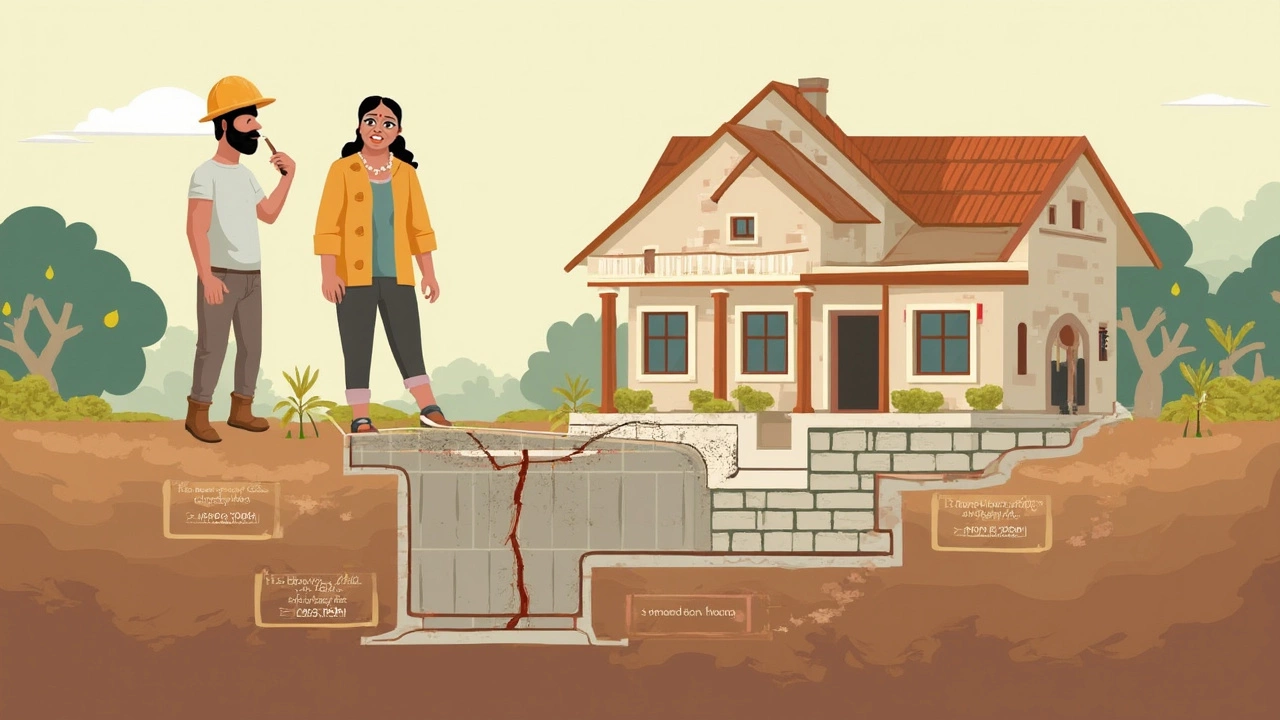Picture this—you’re in your basement, and you spot a long, thin line running like a scar across your home’s foundation wall. Maybe you’ve heard horror stories about foundation problems draining savings or tanking home values. But how much does it really cost to repair a horizontal foundation crack? Grab a cup of coffee, because we’re going deep into what you’ll need to know—honest numbers, why it matters, and how to avoid spending a fortune.
Why Horizontal Foundation Cracks Deserve Immediate Attention
A horizontal foundation crack isn’t just a cosmetic problem. Unlike vertical cracks, which usually signal settling, horizontal cracks almost always point to structural cheerfulness leaving the building. These cracks often mean that soil or outside pressure is literally bending your wall. If you wait, the pressure keeps building—and trust me, concrete isn’t as bulletproof as it looks after years of stress. The American Society of Civil Engineers highlights that horizontal cracks, especially wider than 1/4 inch, often suggest substantial foundation movement. Ignoring them lets water seep in, which can create more pressure, lead to mold, or—worst case—wall collapse.
If you’re thinking, "My house can’t fall over, right?" Well, according to a HomeAdvisor survey from early 2025, severe horizontal cracks are the leading reason for expensive full-foundation replacements, costing homeowners six figures. Inspectors say any horizontal line running the length of a wall deserves urgent professional attention, especially in older homes or those standing on clay-heavy or poorly-drained soil.
So, how does urgency connect to cost? It’s simple: the sooner you spot and fix the crack, the less you’ll pay. Wait, and not only does the repair bill balloon, but you risk losing mortgage options or home value if you want to sell. Lenders almost always require foundation repairs, and buyers back out fast at the sight of those cracks. No pressure, right?
One quick tip: grab a ruler and tape a piece of graph paper or use a crack monitor gauge (they cost under $30 online) over the crack. Check it every few weeks. If it’s growing, call a pro before your repair options shrink and costs rise.
What's Behind the Price Tag? Factors That Affect Horizontal Crack Repair Costs
So, what’s the damage for your wallet? The average homeowner in 2025 pays anywhere from $4,000 to $15,000 to repair a *horizontal foundation crack*, depending on the severity and what’s causing it. Some lucky folks with shallow, stable cracks might get away with $2,500, but let’s break down why costs swing so wildly.
1. Severity and Length of the Crack: A small hairline crack (maybe just a few feet) will need less work than a long crack stretching the length of a basement wall. Anything over six feet—or wider than a pencil—usually means a bigger repair budget.
2. Location and Accessibility: If the crack is buried behind drywall, stairs, or mechanical systems, plan to pay more for demolition and reassembly.
3. Soil Conditions and Water Issues: Clay soils expand with moisture, while sand drains too fast. Both can bust up your foundation. If your lot doesn't drain water away, repairs get tough and pricey. You may also need exterior grading or a new drainage system.
4. Regional Labor Rates: Foundation specialists in big cities tend to charge more than small-town crews, thanks to higher insurance and licensing.
5. Type of Foundation: Concrete block walls can crack differently (sometimes worse!) than poured concrete. Block walls often need steel reinforcement or carbon fiber straps, which ramps up costs.
Here’s an at-a-glance range of what you’ll likely pay for different repair methods in 2025:
| Repair Method | Typical Cost (2025) | Best for | Life Expectancy |
|---|---|---|---|
| Epoxy Injection | $2,500–$6,500 | Small, stable cracks | 10-20 years |
| Carbon Fiber Straps | $3,500–$9,000 | Long, non-bowing cracks (block or poured) | 25+ years |
| Steel Brace Reinforcement | $8,000–$15,000 | Severely bowed walls | 30+ years |
| Excavation & Exterior Waterproofing | $10,000–$22,000 | Major leaks, hydostatic pressure | 30+ years |
These numbers cover labor, materials, and most permits, but surprise fees still pop up—like fixing walls or floors after the work, or handling unexpected drainage issues.

Repair Methods: Choosing the Right Fix for Your Foundation
Let’s get into repair options, because not every crack—or every house—needs the same solution. Some repairs are quick and easy, while others are like minor surgery. Here’s how it breaks down in plain English:
- Epoxy and Polyurethane Injection: This repairs thin cracks that don’t show major wall movement. Epoxy is strong and glues the concrete together—good for dry spots. Polyurethane is flexible, making it better for areas with a lot of temperature swings or moisture risk. Both usually require drilling small holes to fill the crack from inside. Pro crews knock this out in a few hours, but it won’t work if the wall is bowing or the crack is huge.
- Carbon Fiber Straps: This method uses super-strong strips bonded to the wall, preventing further movement. It’s fast—installers often finish in a day—and works best if the wall is cracking but not actually bowing inward too far. The big plus here is no excavation, meaning less mess and cost. Carbon fiber is popular in homes built after 1970 because walls tend to be thinner and need modern backup.
- Steel Brace Systems: If your wall is bowing inward more than 2 inches, you probably need steel beams anchored to the floor and ceiling. It looks dramatic, costs more, and sometimes needs extra work on the outside. It’s not sexy, but it keeps your whole house from moving any farther. Many lenders won’t offer loans until these are installed on severe cracks.
- Excavation and Exterior Waterproofing: Sometimes the only option is to dig all the way to the foundation from outside, patch the crack, add a waterproof membrane, and backfill with gravel. It’s invasive and expensive, but it’s the only solution if water keeps coming back or the soil outside is pushing hard enough to keep bending the wall. Don’t be surprised if crews suggest draining systems like French drains or sump pumps during this work too.
DIY fixes for horizontal cracks aren’t just risky—they’re often short-lived. Hardware store epoxy kits might cost $50, but if you skip what’s causing the crack (like leaking gutters or bad soil), you’re just buying time. Home inspectors almost always spot these patches, and they rarely pass when you want to refinance or sell.
If you’re juggling quotes, make sure every contractor checks the whole foundation, not just the one crack. Look out for mold, musty smells, or signs that the floor above is uneven. And always ask for warranties—ideally in writing, lasting at least 10–20 years. If a company won’t back their work, that’s a red flag.
Smart Tips to Minimize Repair Costs and Avoid Foundation Trouble
Foundation issues feel scary, but most are fixable with the right info and timing. If you want to keep repair costs low, a few habits go a long way:
- Check Your Foundation Every Season: Walk around your home—inside and out—each spring and fall. Look for new cracks, uneven floors, or stuck doors. Early catches mean cheaper fixes.
- Fix Drainage Fast: Most cracks start with water. Make sure gutters work, downspouts aim at least 10 feet from your house, and soil slopes away. If you see puddles up against your foundation after rain, grab a shovel before you grab your checkbook.
- Plant Smart: Trees can be pretty, but deep roots or thirsty species pull water away from the foundation, causing shifting. Keep big plants at least 20 feet away from your walls.
- Get a Professional Inspection: Spending $400–600 on an independent structural engineer saves thousands in the long run. They don’t make money on repairs, so you’ll get honest advice instead of a sales pitch.
- Read Reviews and Check Licenses: Not all “foundation experts” are the real deal. Look for companies with years of local work, good reviews, and up-to-date insurance. Ask for previous customer referrals—and actually call them.
Wondering if insurance covers it? Homeowner’s insurance rarely pays for typical horizontal cracks—they call them "wear and tear." But if a sudden event like an earthquake or burst pipe cracks the wall, you might get help. Call your agent early, snap lots of photos, and keep repair receipts just in case.
Last little nugget: repairs to a *horizontal foundation crack* almost always boost your resale value. New buyers love peace of mind, so adding a transferable warranty can tip a shaky sale into a closed deal. And remember, a sturdy foundation means you sleep better at night—not worrying about waking up to a renovation disaster.
So if you’ve spotted a crack, don’t panic—but don’t wait, either. Get it checked, budget smart, and use the tips here to keep both your house and your wallet standing strong.

Written by Fletcher Abernathy
View all posts by: Fletcher Abernathy